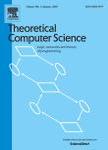版权所有:内蒙古大学图书馆 技术提供:维普资讯• 智图
内蒙古自治区呼和浩特市赛罕区大学西街235号 邮编: 010021

作者机构:Soochow Univ Sch Comp Sci & Technol Suzhou 215006 Peoples R China Soochow Univ Prov Key Lab Comp Informat Proc Technol Suzhou 215006 Peoples R China Huazhong Univ Sci & Technol Sch Artificial Intelligence & Automat Inst Artificial IntelligenceMinist China Key Lab Image Informat Proc & Intelligent Control Wuhan 430074 Peoples R China
出 版 物:《THEORETICAL COMPUTER SCIENCE》 (理论计算机科学)
年 卷 期:2021年第862卷
页 面:250-261页
核心收录:
学科分类:08[工学] 0812[工学-计算机科学与技术(可授工学、理学学位)]
基 金:Natural Science Foundation of the Jiangsu Higher Education Institutions of China [19KJB520013] National Natural Science Foundation of China Priority Academic Program Development of Jiangsu Higher Education Institutions
主 题:Membrane computing Neural computation Spiking neural P system Computation power Universality
摘 要:Spiking neural P systems (SNP systems) are a class of distributed and parallel computation models, which are inspired by the way in which neurons process information by means of spikes, where a neuron fires and distributes the spikes to all the neurons linked by synapses with the firing neuron. In this work, a new spike distribution mechanism is introduced, where the produced spikes are distributed to a set of neurons indicated by the target indications. The computation power of SNP systems with this new spike distribution mechanism is investigated. It is demonstrated that SNP systems with such a distribution mechanism are Turing universal as both number generators and function computing devices. Moreover, it is shown that 6 neurons (respectively, 15 neurons) are sufficient for constructing a universal SNP system with the proposed spike distribution mechanism as a number generator (respectively, as a function computing device). By comparing with the classical one, it can be found that the proposed spike distribution mechanism is a powerful feature in terms of the number of neurons used to construct universal SNP systems. (C) 2020 Elsevier B.V. All rights reserved.